
On Wednesday I got up at 4:30 AM to collect the Hendersons from the airport. This should have been a simple exercise but as usual when I have to get up early – I could not get to sleep. When I eventually did at about 2:30 AM Muffin decided to give an impromptu Morris Dancing performance together with a few circuits of the bed.
I emerged from the nest at 4:30 unwilling to face the day – but managed to collect John and Christine without drama. The only coffee shop open at the airport was the McCafé – but it was not bad at all. It is amazing how few people are in Wien airport at 5:30 AM but it seems that is when the flights start arriving.
On Tuesday I had to go to Schleifmuhlgasse to get some coffee from Alt Wien and then to Wein and Co in Jasomirgottstrasse. The town was heaving with locals and tourist – basking in the sun. The air was filled with the smell of spring and the smoke from millions of cigarettes. Today it was cold and wet and everyone had vanished indoors - and I wore a coat, beanie and gloves.
I nearly killed myself and another cyclist in a head on collision. I was tootling along in a daydream and suddenly saw another cyclist heading towards me at high speed. I instinctively moved to the left – oops - wrong way. He screamed and we both swerved – missing death by inches. Why did I do that? I have been here now for 18 months and know I must be on the right.
Perhaps I get distracted by some of the sights. In Am Heumarkt yesterday I saw a mother with a toddler. She was pushing a pram with (one assumes) a baby in it, was smoking a cigarette and had a mobile phone scrunched up to her ear with her shoulder. It was quite a sight.
In Beatrixgasse a woman was putting her small dog in her car. Before doing so she wiped its bum with a tissue and dropped the tissue on the footpath – my footpath.
In Beatrixgasse a man stopped while his large dog pissed up against the door of an apartment block – my apartment block.
Why do people assume the right to have their animals piss and defecate on public footpaths? What makes them think this is civilized behaviour?
In the Post in Marokkanergasse to collect a parcel. The man asked me to sign for the parcel – before he went to get it. I don’t think about what would happen if I refused to sign before I got the parcel – I know what the result would be – no parcel.
On the counter in the post there is a display case in which Hannah Montana pens are for sale. Disney’s reach is global. It’s not her fault that she is the daughter of Billy Ray Cyrus but it doesn’t help my digestion.
Cate is in Jakarta. She gets back on Friday morning and then we go to Tuscany. I won’t have to worry about whether or not I can get an Internet connection – there is no Internet. There will not be a Blog for a week.
I was blearily shoveling my breakfast into my face this morning while watching TV, and this commercial came on:
I quickly found it on YouTube, along with a handful of similar commercials featuring various pest bugs trying to gain entrance to the homes of unsuspecting and obviously vulnerable people. The hero of course, is the exterminator, who has no spoken lines but prevails nonetheless with his crisp, immaculate uniform and his steely gaze, planting the company's sign in the homeowner's lawn as the vanquished termite leaves the scene behind the wheel of an old car.
This is in no way intended to be an endorsement of the exterminating company. Just a chuckle over the termite.
Side note: Have you seen this site for American climbing conditions? Have you found a crag that is not listed?
RED ROCK CANYON:
-- A new Amenity fee structure will be implemented stating May 1st, 2010. To read more, click here.
-- To digress from conditions...Check out this debate about Dark Shadows (5.8). To summit or not to summit?
--Forecast and average temperatures for Red Rock Canyon.
--Webcam for Red Rock Canyon National Conservation Area.
--The late exit and overnight permit number for Red Rock Canyon is 702-515-5050. If there is any chance that you will be inside the park after closing, be sure to call this number so that you don't get a ticket.
--The entrance to the scenic drive had a parking area for those who wanted to carpool up until approximately April of 2009. That lot has now become employee parking and people who want to carpool are required to park at the lot outside the Scenic Drive exit.
--The scenic drive currently opens its gates at 6 in the morning.
JOSHUA TREE:
-- Joshua Tree Park Ranger Don Robert reports:
"The Superintendent has just announced a temporary closure to the area
around "Towers of Uncertainty", approximately 2.5 miles south on Geology
Tour Road. This area is closed to all public entry and activities for the
protection of natural resources. Specifically , the presence of a pair of
Red-tailed Hawks nesting in very close proximity to a variety of climbing
routes (including but not limited to Reef Rock). This area will be closed
until the nest has been abandoned to ensure the protection of the species
for the duration of the nesting activities.
The perimeter of the closure area is the following UTM coordinates (NAD83):
584984 N, 3759300 E
584984 N, 3758500 E
584000 N, 3758500 E
584000 N, 3759300 E
Thank you for working around this area for the present time. "
-- A recent trip report for J Tree can be found here. The climber has listed the climbs completed, and has sorted them by climbing area and grade. Nice.
--Forecast and average temperatures for Joshua Tree National Park.
--Webcam for Joshua Tree National Park.
NORTHWEST:
-- Forest Service Closes South Sultan River Road.
"Everett, Wash. April 1, 2010— Beginning April 5 officials are closing South Sultan River Road 6122, also known as Jeanne Ring Road, located approximately 17 miles northeast of Sultan, Wash., and a third of a mile southeast of Culmback Dam. The Mt. Baker-Snoqualmie National Forest and Snohomish County Public Utility District are closing the road for a year to prevent road erosion, which will protect water quality in the municipal watershed. The agencies plan to eventually convert the road into a trail for walking and kayak portage to the Sultan River. Officials will install a gate to keep traffic from damaging the road and stop trash dumping. " Click here to find out more.
-- Check out Colin Haley's recent post for Shuksan.
-- WDOTs recent pictures showing clearing of Hwy 20 can be found here.
-- A super resource for Skykomish Valley Climbing can be found here.--Forecast for the West Slope of the Cascades.
--Forecast for the East Slope of the Cascades.
--Webcam for Leavenworth and the Stuart Range.
--Sno-Park permits are available for purchase in Washington State. To purchase a permit and/or read more about them click here.
--Forecast for Mount Rainier.
--Forest Service Road Report for Mount Baker-Snoqualmie National Forest.
--Mount Saint Helens, Mount Adams conditions and recreation report.
--Webcams for Mount Rainier National Park, North Cascades National Park, Leavenworth.
--An up-to-date ski and snow report for the Northwest may be found here.
--Up-to-date Pacific Northwest ice conditions may be found here.
SIERRA:
-- Ice conditions can be found here for the Eastern Sierra.
-- Mt. Whitney lottery info can be found here.
--For up-to-date avalanche and weather reports in the Eastern Sierra, click here.
--Webcams for Bishop, June Lake, Mammoth Mountain, Mono Lake, Tioga Pass.
ALPS:

--A recent report for the Haute Route can be found here, including some good beta about the huts...
--Chamonix and Mont Blanc Regional Forecasts may be found here.
--Webcams for Chamonix Valley, Zermatt and the Matterhorn.
ALASKA RANGE:
--The American Alpine Institute is now accepting applications for the 2010 climbing season. Please call our office at 360-671-1505 for more information.
--Forecast for Denali.
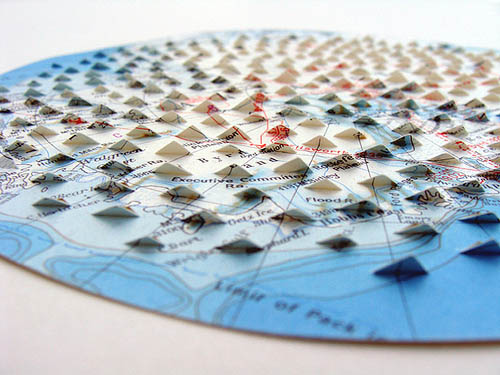 [Image: Work by Shannon Rankin, taken from the artist's Flickr page].
[Image: Work by Shannon Rankin, taken from the artist's Flickr page].
Artist Shannon Rankin does amazing things with maps. Treating them as mere pieces of decorated paper to be manipulated—clipping out spirals, folding crevassed roses of ridges and faultlines, pinning up confetti-like clouds of circles and zigzags—she creates "new geographies, suggesting the potential for a broader landscape." [Image: Work by Shannon Rankin, taken from the artist's Flickr page].
[Image: Work by Shannon Rankin, taken from the artist's Flickr page].
The maps thus become more like the terrains they originally referred to: textured, complex, and subject to eruption. Unexpected forms emerge from below—like geology, overlapping, igneous, and dynamic. 

 [Images: Shannon Rankin, taken from the artist's Flickr page].
[Images: Shannon Rankin, taken from the artist's Flickr page].
Outlines of new island continents appear in the process, polar regions and archipelagoes that out-Dymaxion Buckminster Fuller in their collaged vortices and coasts. 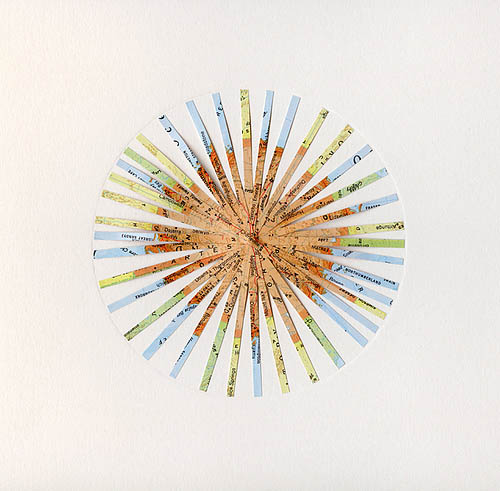 [Image: By Shannon Rankin, taken from the artist's Flickr page].
[Image: By Shannon Rankin, taken from the artist's Flickr page].
All of the works you see here come from Rankin's Flickr page—specifically, the Uncharted, Bayside, ETA6, Maps, and Aggregate sets, where there are many other images to see. 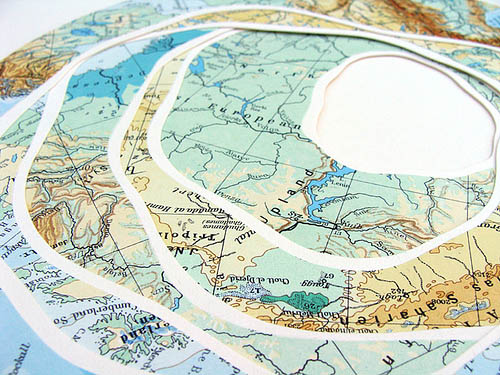
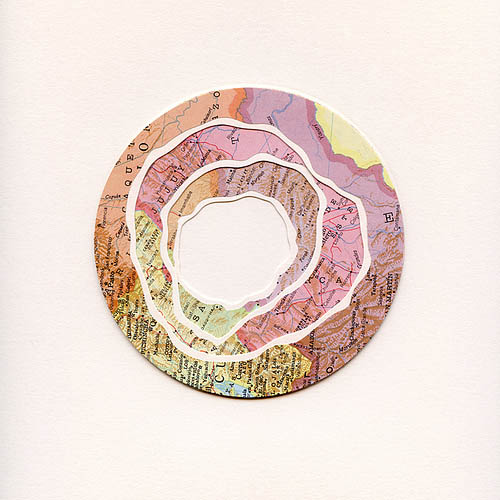
 [Images: All works by Shannon Rankin, taken from the artist's Flickr page].
[Images: All works by Shannon Rankin, taken from the artist's Flickr page].
But seeing these makes me want to feed full-color sheets of obscure maps through laser-cutting machines, slicing elaborate and random geometries to reveal the longest possible distance between two adjacent things, or to discover previously unknown proximities, the whole Earth cut-up and unspooled like a lemon rind.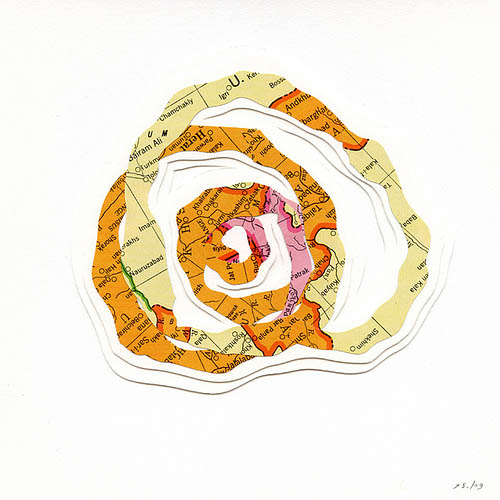 [Image: By Shannon Rankin, taken from the artist's Flickr page].
[Image: By Shannon Rankin, taken from the artist's Flickr page].
There are a variety of distinct styles at work, as you can see, from tiling and tesselation to straight-ahead origami.
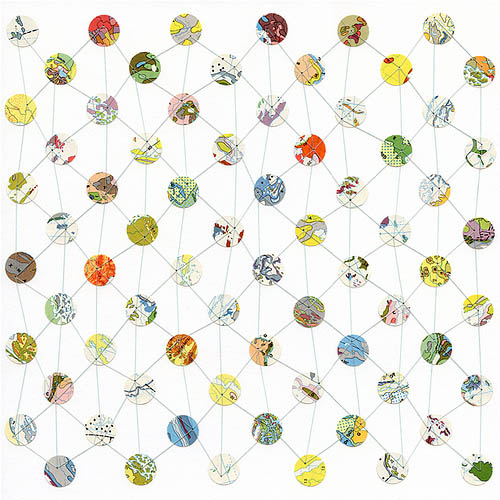
 [Images: All works by Shannon Rankin, taken from the artist's Flickr page].
[Images: All works by Shannon Rankin, taken from the artist's Flickr page].
Another approach is to reduce every map to capillaries—pure roads. The geography is simply how you get somewhere.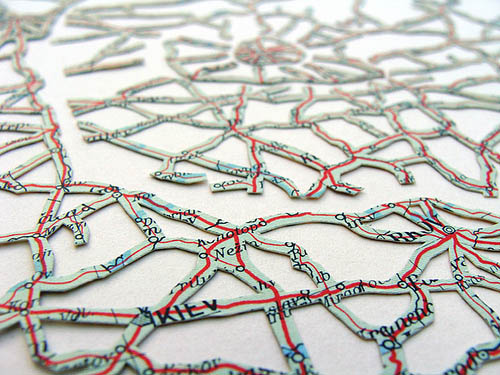 [Image: Work by Shannon Rankin, taken from the artist's Flickr page].
[Image: Work by Shannon Rankin, taken from the artist's Flickr page].
And lest all of these look diminutive, or simply too tiny to see, the scale of execution is often surprising. 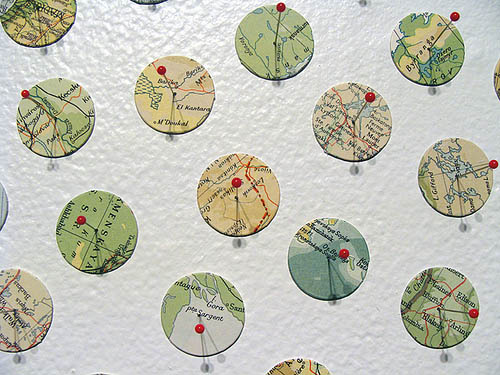

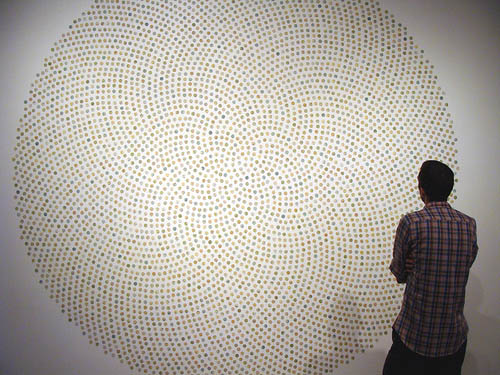 [Images: By Shannon Rankin, taken from the artist's Flickr page].
[Images: By Shannon Rankin, taken from the artist's Flickr page].
If you want to see some of these in person, meanwhile, work from Rankin's Convergence set are on display now through April 17 at the Craftland Gallery up in Providence, RI.
Consider supporting her work, as well, by purchasing a piece or two; you can contact the artist via her webpage.
(Originally spotted via Data is Nature).
We've been meaning to visit Laguna Coast Wilderness Park for a long time. Yesterday, we finally went. We got a late start and it was hot, so we pooped out pretty quick, but it was really pretty out there, and there were lots of bugs.
metalmark butterfly
some bug's backside
This moth's eyes seem big, for a moth. Makes it look cuter, I think.


Anybody know what these are? Some kind of beetle larvae? They were on some coastal sage (I think).
Update: I think these are Trirhabda geminata, also known as the Encelia leaf beetle and the Brittle Bush leaf beetle. They live on sage scrub plants from the desert to the coast.

A snakefly.

Not really happy with the way my photos are turning out these days. I could blame the camera, but ... eh, The pictures above are all new or unusual sightings for me. Most of the rest got tossed into the virtual trash can.
My clearest memory of my birthday last year, was driving my son and some of his friends home from cricket accompanied by their incessant armpit farts the whole way. An hour and a half of armpit farts tends to taint festivities in my experience.
And since then?
Well I joyfully founded Rory's Garden, ran a 12km fun run and became a surf lifesaver. I've mourned the loss of my grandmother, and somewhere in there I continued my lifelong journey of being a wife and mother and trying to be better at it. I finally figured out what I really wanted to be doing work-wise and I'm going for it.
I read this in a book recently: " If you're not pushing yourself beyond the comfort zone, if you're not constantly demanding more from yourself-expanding and learning as you go-you're choosing a numb existence. You're denying yourself an extraordinary trip."
The writer himself is an ultra marathoner called Dean Karnazes and his book has really highlighted for me that some people are crazy that my 21km half marathon later this year is just one small landmark in what I hope will continue to be an exciting and wonderful year ahead.
My goal of becoming a full time writer doesn't seem so unreasonable now.
My goal of being fit and healthy will, as always, be a work in progress.
The biggest realisation is that I spent so much of my life waiting for the other shoe to drop, for it all to come crashing down, I now know even if it does, I'll figure it out.
I am surrounded by people who love me, who continually encourage me to strive to be extraordinary, to do the extraordinary.
Many of you read my blog. Many of you continue to encourage me, to question me, to challenge me.
Thank you.
And I hope you'll make time to eat some cake today.
Because it's my birthday.
I'd like that.
The old Texas Tuxedo is back, according to Vogue, who declares "head to toe is the newest way to wear denim."
I am not sure that is entirely true. For all my years, head to toe denim has been around. From the glam-rock bands of the 70's till now. But all of a sudden some lame-ass designer declared it back and here to stay, for at least 6 weeks.
And how to wear it??
"Mix up textures: Chloe had patchwork jeans with a chambray shirt, while the jeans at D&G and Ralph Lauren were ripped and frayed."
Thanks Vogue UK - but I have other ideas I would like to share.
Denim Jumpsuit
For a seamless, effortless, chic effect. Pale denim with matching shoes. It is timeless. It is unisex. Seams down the front of the leg add a sophisticated touch. Just looks like he is waiting for Rick Astley. Bravo!
Double Denim Celebrities
Never ones to out a foot wrong in the style stakes, Britney and Justin are just divine. My only advice would be to add some accessories. Liven it up a bit. Otherwise perfection. They made magic together.
Denim + Denim + Bedazzler + Camel Toe = Stunning
Now this lass does not need to think about anything. She has hit all the right marks with this outfit. The hair is perfection. The chandelier earrings are a nice touch. I love the cheeky rhinestone t-shirt peeking out under the jacket - and about the jacket - fits like a glove. So do the jeans, particularly in the crotchall area. And one can never have enough fringing. NEVER.
So how do you work the double denim look into your everyday wear? I took inspiration from Abby-Lee walking the catwalk this season. I already had a the main elements in my closet and I am sure you will as well, they being jeans. This is an easy trend to get into and one that will take you from day to night with a change of earring. Let me walk you through this look - (I am on the right)

Turn up your sleeves a bit. Go with a neutral boot. Do not wash your hair. Choose either sunnies or a trucker cap - not both as you may end up looking silly. I also added a splash of colour with a red t-shirt, which I may end up regretting.
I hope this style guide has been of some use to you as you find your way through this maze we call fashion. I look forward to bringing you more key trends over the AW 10 season. Next up.......... Making it happen with Mumus.
OM jag flyttar från Göteborg framöver kommer jag nog sakna Skatås mest av allt. (Inget flyttande är bestämt alltså, men mer och mer pekar ju på att det eventuellt blir så förr eller senare.) Mitt älskade Skatås. Idag var det vår där. Visserligen var det vår överallt, men där var det liksom lite extra vår. Detta trots att det faktiskt låg lite snö kvar här och var i backen där jag duktigt sprang min backlöpning. Duktig var precis det jag kände mig för det gick faktiskt rätt segt. Det finns tre anledningar till det:
1. Jag tävlade i söndags.
2. Jag är inte van vid backträning just nu.
3. Jag köre löpskolning innan själva backintervallerna.
Det där med löpskolningen är ju intressant. Vad jag vet rekommenderas man att köra denna innan backlöpningen, men jag har alltid envisats med att köra den efteråt eftersom det har känts bättre på något sätt. Men idag testade jag för en gångas skull att köra den innan, men det skulle jag ju inte gjort. Jag blev ju bara trött och seg av det. Visserligen kanske man inte ska köra så länge som 17min (Och kanske inte 100utfallssteg, även om de inte kändes av så mycket just när jag gick dem.), men ändå. I fortsättningen fortsätter jag att köra på mitt sätt.
Segt eller ej, det var vår i luften och jag befinner mig fortfarande i nåt slags rus efter söndagens bedrift så det spelar ingen roll. Och det var härligt att vara tillbaks i finaste Skatås igen. Nu har jag (om inget oförutsett händer (läs; jag får ett "riktigt" jobb i sthlm)) en hel lång vår och sommar att spendera bland mördarbackar, rådjur och småstigar!
The Nashville duo is about to release their sixth album called "Chasing After Shadows... Living with the Ghosts" in May and you can get prepared for it by listening to their last one, "Maybe They Will Sing for Us Tomorrow" from two years back.
While writing the previous post, about sound and warfare in Iraq, I came across a brief description of something called an acoustic shadow and its occurrence during the American Civil War.  [Image: Map via University of Maine Civil War Webquest].
[Image: Map via University of Maine Civil War Webquest].
An "acoustic shadow" is when the sounds of an event—here, a battle—cannot be heard by people nearby—say, in the neighboring valley or a parallel city street—but those same sounds can plainly be heard over much larger distances. This effect is caused by "a unique combination of factors such as wind, weather, temperature, land topography, forest or other vegetation, and elevation," we read. For example, "battle sounds from Gettysburg fought on July 1, 2, and 3, 1863 could be heard over one hundred miles away in Pittsburgh, but were not heard only ten miles from the battlefield."
Without my own access to contemporary accounts of these battles and their acoustic shadows—sonic phantom limbs haunting distant landscapes—I simply have to trust the accounts that I'm quoting from here; nonetheless, these stories are fascinating. "More than 91,000 men were engaged in battle at Gaines's Mill, Virginia on June 27, 1862," for instance. "Confederate commanders and troops were less than two miles from the battlefield and could plainly see the smoke and flashes from the guns and artillery, but not a sound could be heard of the battle for two hours. Strangely, the battle sounds from the Battle of Gaines's Mill were easily heard in Staunton, Virginia over one hundred miles away."
The unexpected atmospheric reflection of sound, and sound's complicated relationship with certain topographies, levels of humidity, climatic systems, and more presents an amazing—if impossibly complex—dimension to the future of urban design and landscape architecture. Could 5th Avenue be retrofitted to cultivate acoustic shadows—or might a neighborhood in eastern Brooklyn someday find itself overhearing distant traffic events and individual human conversations that have been carried on the winds from Midtown, acoustic effects soon traced back to the mirage-like venting of a new steam plant on the East River?
This also makes me wonder if instances of ghostlike visitation in ancient times—a king crazed by invisible whispers in his fortified tower bedroom, a city cursed by nocturnal voices, a village terrified by bodyless beasts unseen by any hunter—might actually have been examples of acoustic shadows. How could acoustic shadows be archaeologically and historically investigated without exactly reproducing the landscape topography and climatic conditions of the time?
(Vaguely related: a very old post about sound mirrors).
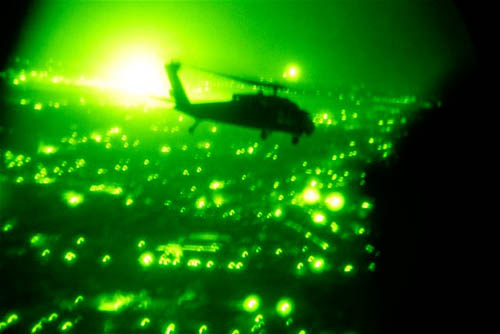 [Image: U.S. helicopter over Baghdad, via (scroll down)].
[Image: U.S. helicopter over Baghdad, via (scroll down)].
I've mentioned The Forever War by Dexter Filkins before, but I was struck again the other day by a passage in which Filkins catalogs the mechanically unprecedented sounds of the American siege of Falluja, a collection of noises so alien and overpowering that he describes it as "an entire ecosystem" with its own hidden predators and prey.
Filkins writes that "rocket-propelled grenades whizzed out of the darkness, striking the M-1s and exploding but doing no harm. Whoosh-bang, like a fireworks show. Whoosh-bang." He quickly adds, however, that "the real weirdness was circling above."
- The night sky echoed with pops and pings, the invisible sounds of frantic action. Most were being made by the AC-130 gunships, whose propellers were putting out a reassuring hum. But over the droning came stranger sounds: the plane's Gatling gun let out long, deep burps at volumes that were symphonic. Its 105mm cannon made a popping sound, the same as you would hear from a machine that served tennis balls. A pop! followed by a boom! Pop-boom. And then there was the insect buzz of the ScanEagle, the pilotless airplane that hovered above us and beamed images back to base. It was as if we were witnessing the violent struggles of an entire ecosystem, a clash of airborne nocturnal beasts we could not see.
But, while an acoustic history of war has yet to be written—though some have treated sound itself as war—it would be a fascinating study to pursue.
World War II Memorial - Red Square
Europeans generally don’t understand Americans and think that America is a strange country full of very strange people. There are some good reasons for the way they think.
I have just finished reading a book called ‘Wingnuts’ by John Avlon of the Daily Beast. This is a fascinating book about the fringe dwellers on both the left and the right in the USA and the crazy worlds they inhabit.
He talks about Bush Derangement Syndrome and Obama Derangement Syndrome and about the ‘Truthers’ (The 9/11 attacks were carried out by the USA) and the ‘Birthers’ (President Obama was not born in the USA).
He quoted a few figures in there about what Republicans believe and this prompted a Harris Poll which confirmed some really scary things about Republicans:
“Harris poll reveals Republican attitudes about Obama: Two-thirds think he's a socialist, 57 percent a Muslim—and 24 percent say "he may be the Antichrist."
To anyone who thinks the end of the health-care vote means a return to civility, wake up.
Obama Derangement Syndrome—pathological hatred of the president posing as patriotism—has infected the Republican Party. Here's new data to prove it:
• 67 percent of Republicans (and 40 percent of Americans overall) believe that Obama is a socialist.
• 57 percent of Republicans (32 percent overall) believe that Obama is a Muslim
• 45 percent of Republicans (25 percent overall) agree with the Birthers in their belief that Obama was "not born in the United States and so is not eligible to be president"
• 38 percent of Republicans (20 percent overall) say that Obama is "doing many of the things that Hitler did"
• Scariest of all, 24 percent of Republicans (14 percent overall) say that Obama "may be the Antichrist."
You can read the full story at the Daily Beast and the Harris Poll details have been published across the media.
See, Europeans see this and scratch their heads and say 'why would anyone think that President Obama was not born in the USA. You cannot BE President unless you are born in the USA'
(Much the the dismay of Austrians who would like Arnold Schwarzenegger to be President).
Europeans generally believe that something should make sense if it is to be believed (although they do of course, like most others, make an exception for religion).
Now I think all this stuff is amazing, scary - and immensely entertaining - but if I was an American I would be seriously worried about where the country is going.
I know only sane and intelligent Americans read my Blog and I think you had better start doing something about this stuff or it will be curtains for all of us.
Pulling sleds on an expedition is very much a love-hate relationship - one that is unquestionably weighted towards the latter. For the most part, sleds are a beast of burden and a huge pain in the posterior. I have seen the exasperated faces of Denali climbers doing battle with their sleds countless times, and everyone seems to think, “surely there must be a better way.” There are definitely some methods that are better than others, but in the end, sleds are inconvenient, cumbersome, get in the way, and frustrate you to no end. During the moments where your sled is working smoothly and efficiently, revel in it, because soon the path ahead will change and it will be pulling you off balance, tripping you, getting tangled in the rope, and flipping over. Don’t worry - it is all par for the course and part of the joys of expedition climbing. Some sleds come with pre-made attachment points. If On the nose of the sled, form a loop for an attachment point An overview of the nose rigging on the sled. The red To attach the sled pulls to your pack, use two non-locking carabiners and either a fisherman’s knot or a figure eight. Use these knots to adjust the length of your sled pulls to your ideal distance from the sled. The tail rigging (same loop as for the nose) and duffel bag tether.
Having set the stage for frustration, I can now say that sleds are invaluable tools on expeditions like Denali’s West Buttress. The hassle is more than worth the benefit of not having to carry all that gear on your back.
Below you will find a description of a system that AAI uses to rig and pull expedition sleds. What method will work best for you will ultimately depend on your sled and pack models and what feels best given your dimensions and load.
Some basic principles of pulling sleds are as follows:
• The majority of the sled weight should be born by your hips and not your backpack or shoulders.
• Some form of a sliding or self-equalizing attachment point for the sled tether/sled attachment is very useful in maintaining equal load on each tether while traversing or on uneven terrain.
• Make sure your attachment system is redundant and that total failure of loss of a sled is not possible.
• Be patient. When you get tripped and fall down for the 10th time that day, chuckle and remember that you aren’t working and you are in the mountains, so how bad can it be?
• Mind the sled in front of you. Don’t forget, when going downhill on a rope team, you are responsible for managing the rope and sled in front of you. This means constantly paying attention and putting forth continual effort to keep the rope and sled from running into the pack of your buddy.
• Experiment with different set-ups if yours does not feel manageable or sustainable. If your sled seems like an unmanageable burden or if it puts unbearable weigh on your pack, mix it up a bit and use the principles contained herein to guide your experiments.
Gear needed (diagram and labels in photo below):
1. 2 x non-locking carabiners
2. 1 x 11 to13-foot piece of 6 mil cord for sled pulls/tethers
3. 2 x 3-foot pieces of 6 mil cord.
4. 1 x Expedition Sled
5. Attachment points for duffel tether.
6. 25 feet of 4 mil cord for duffle bag tether
7. 1 x locking carabiner for rope attachment.
8. 1 x locking carabiner or a pulley.
Rigging Your Sled
1. Make sure your sled has attachment points or loops for your duffel bag tether feed through. These are labeled #5 in the photo. If your sled doesn’t have them, they are easy enough to fashion with any thin cordage.
yours doesn’t have them, they are easy to make from thin cord.
2. Form the nose and tail attachment points with the two pieces of 3-foot 6 mil cord. Do this by making a loop from the cord using a double fisherman’s knot threaded through holes in the sled. The length of the cord will depend on your sled and the hole configuration. Three feet seems about right for most models. This attachment point needs to be a loop using a secure knot. This will prevent loss of the sled if one hole in the plastic were to fail.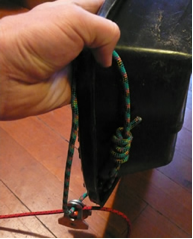
using the 3-foot sections of 6 mil cord and a double fishermans knot.
3. Set up your sled pulls using the 11 to 13-foot length of 6 mil cord and the two non-locking carabiners. There are a few ways to attach the sled pull to the nose attachment point. My favorite, even though it is more gear intensive, is to use a small crevasse rescue pulley. This allows the sled pulls to run freely through the attachment point and to remain equalized on uneven terrain. To do this, I run the nose attachment cord through the carabiner hole in the pulley and they run the sled pulls through the pulley wheel hole. A carabiner can also be used in place of the pulley, but this would allow the sled pull to slide all of the way through the carabiner should one of the pack attachment points come undone. As long as you build redundancy into your sled attachment, this shouldn’t be much of a concern.
cord is the sled pull cordage which will attached to your pack.
4. Fashion your attachment method for the sled pulls. Again this can be done a number of ways. I recommend either a figure-8 or fisherman’s knot on a non-locking carabiner as pictured below. These will attach to your backpack.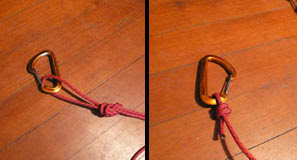
5. Attach your duffel bag tether. This is the 25-foot piece of 4 mil cord that will be used to tied your duffel bag and gear to your sled. I usually tie one end of this directly to your nose or tail attachment point of the sled rather than one of the smaller and weaker attachment points as in the picture.
6. Attach your sled pulls to your pack. Unfortunately, there are many variables in this aspect of the rigging process. What system will work best depends on the configuration of your pack and a few other factors that can’t really be assessed ahead of time. Remember the principle concern is to get the weight of the sled onto your hips and not the pack itself. Below is a diagram that shows an attachment point that works well on the Gregory Pro pack. Most other similarly sized packs have an attachment point on or near the wait belt that can work well. If your pack doesn’t have a suitable attachment point on the waist belt, one can be fashioned by wrapping 6 mil cord around you pack and forming a power point to attach the sled pulls to. In my experience, this is a less user-friendly and efficient method and should be a last resort.
Setting the length of your sled pulls for optimum distance from your sled can be tricky, and it is something that you will get a feel for over time. As a general rule, I think it works best to have the sled pulls as short as possible while having them far enough away from your feet that they won’t easily interfere with walking. Bear in mind that on the descent, the person behind you will be managing your sled, which will tend to chase you down the hill, and so you don't want the sled pulls too tight or it will be more difficult for your sled manager to keep the sled from hitting your feet.
7. Attach the sled to the climbing rope. In most cases while in glacier travel mode, you will want your sled tied into the climbing rope. This is most often and most easily accomplished by using a clove hitch on the locking carabiner (see tail rigging photo above). Tying the climbing rope into the sled servers a few different purposes. First it allows the person behind you on the rope team to manage your sled while going downhill. Second, it provides some redundancy to your primary sled attachment to prevent loss of a sled in the even of a crevasse fall or knot/equipment failure in the primary system.
8. The last and final step…PULL!!
To view a pdf version of this article, download here.
To get in touch with Coley, please email him at cgentzel@aai.cc. AAI runs several expedition training programs, such as our 7-Day Alaska Mountaineering - Denali Prep. We also run seven Denali Expeditions each season.
--Coley Gentzel, Denali National Park Climbing Ranger and former AAI Guide
Last week MGMT released their new album "Congratulations" as a stream and today they've got a video for the non-hit single "Flash Delirium". Yes, it's fun and zany and yes, it's creepy and all about old people and a singing neck.
Watch the video below or here and listen to the album here.
Lưu trữ Blog
-
▼
2010
(3068)
-
▼
tháng 3
(221)
- I get distracted by some of the sights
- How termites get into your house
- Conditions Report - March 31, 2010
- New World Order
- Venturing to South County for a change
- Calosoma beetle
- Birthday girl
- Trend Alert - Double Denim
- Älskade Skatås
- HAMMOCK - BREATHTURN
- PHOTOART OF WHITE WHITE BROWN TWIG
- Events in the Landscape and their Acoustic Shadows
- Warsound
- The crazies are taking over!
- Expedition Sled Rigging
- MGMT - FLASH DELIRIUM VIDEO
- Week Ending March 28 (WS - 12 weeks)
- Hooga Hooga Hooga Chakka!
- UIAA Gear Testing Videos
- Quick Links 9
- Dagen efter 44:30
- I hear you Sister (Mary)!!
- Supermodel
- When a little says a lot.
- Antelope Island 50k
- Vad hände?
- April and May Climbing Events
- Inside Hoi
- Tofu Noodle Soup
- Playlist - 27th March 2010
- Table of Contents
- The Extra Room
- L.A. on the Nile
- Gissa tiden
- For want of an "a" the blog was lost
- Eraser drawing
- And the winners are:
- Zoo Welcomes 25 Baby Dragons
- Strawberry and Dark Chocolate Ice Cream Cone Cupcakes
- Vivarium
- Snake Bites - First Aid and Prevention
- Var ska jag börja?
- Hero's and Villains
- Whoopie Pies
- First Post for An American Cupcake in London!
- It's not our fault John
- Klip House
- Netflix via Wii - Coming Soon
- GLASS CANDY - FEELING WITHOUT TOUCHING
- DELOREAN - STAY CLOSE
- Wail of woe
- Urban Fossil Value
- Imagine a €10 lunch in Vienna!
- Pannkaksplatt
- CANDIE - ELEPHANT MAGAZINE
- Conditions Report - March 24, 2010
- TANLINES - SETTINGS EP
- What actually happened
- Dear Mr President
- Spare me from exploring cats
- YACHT - THE AFTERLIFE
- YUCK - "GEORGIA" + HERZOG - "PAUL BLART AND THE DE...
- PHOTOGRAPHY BY ANASTASIA CAZABON
- Sunburns in the Mountains
- Halsen hänger på..
- Just like living with Tony Barber..........
- Kylie and Mia (and a giveaway)
- Shanghai Seedling
- Yep - it's FUBAR
- Access Restricted
- Migratory Anagram
- GOLDFRAPP - HEAD FIRST
- MGMT - CONGRATULATIONS
- Döda ben - döda ben
- In Defense of Soloing
- Crock-a-doodle-dooooo!
- Judge Not- Part 2
- And the winner is:
- Week Ending March 21 (WS minus 13 weeks)
- March and April Climbing Events
- Borrego Bugs
- Playlist - 20th March 2010
- ctrl-alt-del
- Weekend Warrior - Videos to get you stoked!
- Heros, Villians and the week that was.
- California City Expedition Update!
- PHOTOGRAPHY OF JEFF LUKER
- HIGH PLACES - THE LONGEST SHADOWS
- Vertical Limit - An Instructional Video
- Regn, ösregn, ösregn plus blåst
- Please say hi to Mr Moo.
- Ultralöpning i Göteborg
- Two L.A. Evenings
- Spring has Sprung
- Climbing and Outdoor News from Here and Abroad - 3...
- Bad Boyz Bad Boyz - What you gunna do.
- Status
- Wet Pussy
- Toddler terror and a lovely giveaway
- Friends Update
-
▼
tháng 3
(221)












